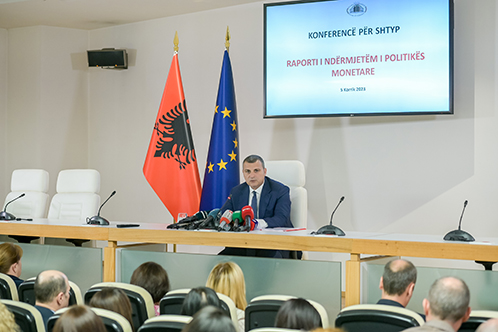BANK OF ALBANIA
PRESS RELEASE
Governor Sejko: Statement to the Press Conference on Monetary Policy Decision, 5 July 2023
Publication date: 05.07.2023
Dear ladies and gentlemen,
Today, on 5 July 2023, the Supervisory Council of the Bank of Albania reviewed and approved the Intermediate Monetary Policy Report.
The new information analysed suggests the Albanian economy continued to grow in the first half of 2023, albeit at a slower pace than in the previous period. At the same time, inflation has been coming down, mainly reflecting the decline in imported inflation.

These developments resulted, overall, in line with the trends in global economy and with our expectations. In addition, the updated projections suggest these trends will be present in the future as well: economic activity in Albania is expected to grow in the quarters ahead, while inflation is expected to gradually decline and return to the target in the first half of 2024.
Against this backdrop, the Supervisory Council assessed that the current monetary policy stance remains adequate. Nevertheless, the Supervisory Council concluded that domestic inflationary pressures remain elevated, and meeting our price stability objective may require a further normalisation of the monetary policy stance in the future.

Inflation came down in the second quarter of 2023, recording an average value of 4.7% in April and May 2023. The decline in inflation in processed foods, oil and related products dictated this dynamics, while inflation of other basket items has appeared relatively stable.
From macroeconomic perspective, the downward trend of inflation reflected the similar performance of this indicator across our trading partners, the strengthening of the lek exchange rate against the euro, and the effect of the high comparative base. On the other hand, domestic inflationary pressures continue to remain elevated, in reflection of the high demand for goods and services, the tight labour market conditions and the fast growth in wages and labour costs.
According to INSTAT data, the volume of the economic activity in Albania grew by 2.7% in the first quarter of year, decelerating compared to the previous quarter and on the downside of our expectations. Economic growth resulted at a broad base, in terms of both sector and aggregate demand components. At the same time, the deceleration of growth rate was at a relatively high base, though more pronounced in the sectors of construction and industry as well in household consumption component.
In macroeconomic view, the increase in the demand for goods and services has reflected the sound financial balance sheets of private sector, the still favourable financing conditions and the growth in the export of Albanian services, mainly in tourism. On the other hand, fiscal policy provided a neutral impact, while the rise in the international trade balance provided a negative impact.
The further expansion of aggregate demand - although slowing down - has been reflected in a high capacity utilisation rate in the economy. This phenomenon is more pronounced in the labour market. Available data for the first quarter suggest the continuing trend of growth in employment and wages, thus supporting the expansion of households’ purchasing power and keeping domestic inflationary pressures high.
The normalisation of monetary policy stance implemented by the Bank of Albania has helped financial markets operate calmly. Regardless, the reduced interest rates on government securities and loans in lek and the fast strengthening of the exchange rate have characterised these markets in the second quarter of year. On the one hand, the drop in lek interest rates has reflected the good liquidity situation in financial markets and the reduction of risk premia perceived by its agents. On the other hand, the strengthening of lek exchange rate has reflected the continuous improvement in the international trade balance, as well as the increase of interest to save and invest in our domestic currency.
Overall, the normalisation of the monetary policy stance has created more adequate financial conditions for controlling inflation. However, financial conditions - though towards tightening- still remain simulating for the growth in consumption and investments. In response to them, credit to private sector continues to drive up, while credit portfolio quality has remained at satisfactory levels, as evidenced by the low levels of non-performing loans ratio. Financial soundness of banking sector suggests the latter will be able to continue accommodate the economy demands for funds.
The updated projections show that the Albanian economy will continue to grow and inflation will gradually decline and turn to the target in the first half of 2024.
The fall in inflation will reflect both the further reduction of inflation across global markets and the normalisation of monetary policy stance in Albania. This normalisation will: provide a better balance between demand and supply; support the stability of financial markets; and help control economic agents’ expectations on inflation.
On the other hand, economic activity is expected to grow in the following quarters. The growth pace is expected to slow down slightly in the next two years, and return to historical levels in the medium and long term. This forecast factorises the good financial soundness of private and banking sectors in the Albanian economy, the positive perspective on labour market, the improved households and enterprises’ confidence, and the presence of a still accommodative financial environment.
***
Judging on the above, the Supervisory Council decided to:
- Keep the policy rate unchanged, at 3.00%;
- Keep the overnight lending rate unchanged, at 4.00%
- Keep the overnight deposit rate unchanged, at 2.00%.
The Supervisory Council deems that the elevated inflationary pressures from the domestic economy remain a risk factor to price stability in Albania. In these circumstances, the Supervisory Council will carefully monitor the situation to assess on an ongoing basis the inflationary pressure dynamics and to identify in a timely manner the necessary measures to achieve the target, including the further normalisation of monetary policy stance.
In any case, the monetary policy stance will provide the necessary conditions to safeguard the price stability objective in the medium term, by simultaneously paying attention to minimise its impact on restricting the economic activity, and potential adverse consequences on financial stability.

 Twitter
Twitter
 Youtube
Youtube
 Facebook
Facebook
 Flickr
Flickr
 RSS
RSS
 Subscribe
Subscribe
 Feedback
Feedback